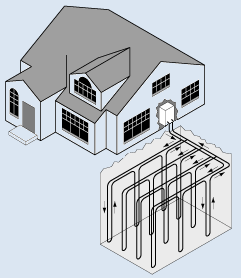Geothermal systems are home heating and cooling systems that gather heat from the earth. Geothermal heat pumps (GHPs) use the relatively constant temperature of sub-surface soil as the exchange medium.
- As of 2004, five countries -- El Salvador, Kenya, the Philippines, Iceland and Costa Rica -- generate more than 15% of their electricity from geothermal sources. In Iceland, geothermal energy is so cheap that some sections of pavement are heated.
- In the United States, roughly 50,000 geothermal heat pumps are installed every year. The U.S. leads the world in geothermal exploitation.
- The combined production of geothermal energy for all uses places third among renewable energy sources, following hydroelectricity and biomass, and ahead of solar and wind.
Benefits of Geothermal Energy:
- energy efficiency. GHPs require 25% to 50% less electricity than conventional heating and cooling systems. According to the EPA, geothermal heat pumps can reduce energy consumption — and corresponding emissions — up to 44%, compared to air-source heat pumps, and up to 72%, compared to electric resistance heating with standard air-conditioning equipment.

- design flexibility. Geothermal heat pump systems can be installed in both new and retrofit construction. Equipment rooms can be scaled down in size because the hardware requires less space than is needed by conventional HVAC systems. GHP systems also provide excellent "zone" space conditioning, which allows different parts of a home to be heated or cooled to different temperatures.
- durability. Since GHP systems have relatively few moving parts and the parts are sheltered inside a building, the systems are durable and reliable. The underground piping often carries warranties of 25 to 50 years, and the heat pumps can last more than 20 years. The components are easily accessible, which helps ensure that the required maintenance is performed on a timely basis.
- noise reduction. As they have no outside condensing units (such as those in air conditioners), there's no noise outside the home. Geothermal heat pumps are so quiet inside of a house that users may not be aware they are operating.
How do geothermal systems work?
A geothermal heat pump, unlike a furnace, does not create heat by burning fuel. Instead, it collects the earth's natural heat through a series of pipes, called a loop, installed below the frost line. At that depth, which varies by climate zone, the soil remains at a relatively constant temperature throughout the year. Fluid circulates through the loop and carries heat to the house. There, an electrically driven compressor and a heat exchanger concentrate the heat and release it inside the home at a higher temperature, where ductwork distributes the heat to different rooms. In summer, the underground loop draws excess heat from the house and allows it to be absorbed into the earth. The system cools the home in the same way that a refrigerator keeps food cool -- by drawing heat from the interior, rather than by forcing in cold air.
Types of Systems
According to InterNACHI, there are four basic types of geothermal systems. Selection of the most appropriate system depends on the climate, soil conditions, available land, and local installation costs at the site. All of these systems can be used for residential and commercial building applications. They include:
- horizontal: This type of installation is generally the most cost-effective for residential installations, particularly for new construction where sufficient land is available. The most common layouts use either two pipes (one buried at 6 feet, and the other at 4 feet), or two pipes placed side-by-side buried 5 feet in the ground in a 2-foot wide trench.
- vertical: Large commercial buildings and schools often use vertical systems because the land area required for horizontal loops is prohibitive. Vertical loops are also used where the soil is too shallow for trenching, and they minimize the disturbance to existing landscaping. For a vertical system, holes (approximately 4 inches in diameter) are drilled about 20 feet apart and 100 to 400 feet deep. Two pipes are inserted into these holes and connected at the bottom to form a loop. The vertical loops are connected to the heat pump in the building.
- pond/lake: A supply-line pipe is run underground from the building to a body of water and coiled into circles at least 8 feet under the surface. In order for the body of water to be adequate, it must meet minimum volume, depth and quality criteria.
- open-loop system: This type of system uses well or surface water as the heat exchange fluid that circulates directly through the GHP system. Once it has circulated through the system, the water returns to the ground through the well, a recharge well, or surface discharge.
 This option is practical only where there is an adequate supply of relatively clean water, which must comply with local codes and regulations regarding groundwater discharge.
This option is practical only where there is an adequate supply of relatively clean water, which must comply with local codes and regulations regarding groundwater discharge.
Cost
A geothermal system usually costs about $2,500 per ton of capacity. A typical home uses a 3-ton unit costing roughly $7,500. That initial cost is nearly twice the price of a regular heat pump system that includes air conditioning. The cost of drilling, however, can be considerable; drilling can cost in excess of $30,000, depending on the terrain and other local factors. Systems that require drilling vertically deep into the ground will cost much more than systems where the loops are in a horizontal fashion and closer to the surface. Despite these initial costs, a geothermal system saves enough on utility bills that the investment is often recouped in five to ten years.
International Association of Certified Home Inspectors (InterNACHI) is the world's most elite, non-profit inspection association.
President, ComInspect, www.cominspect.com
Director, Master Inspector Certification Board, www.certifiedmasterinspector.org
Author, 15 books and Co-Host of http://www.NACHI.TV